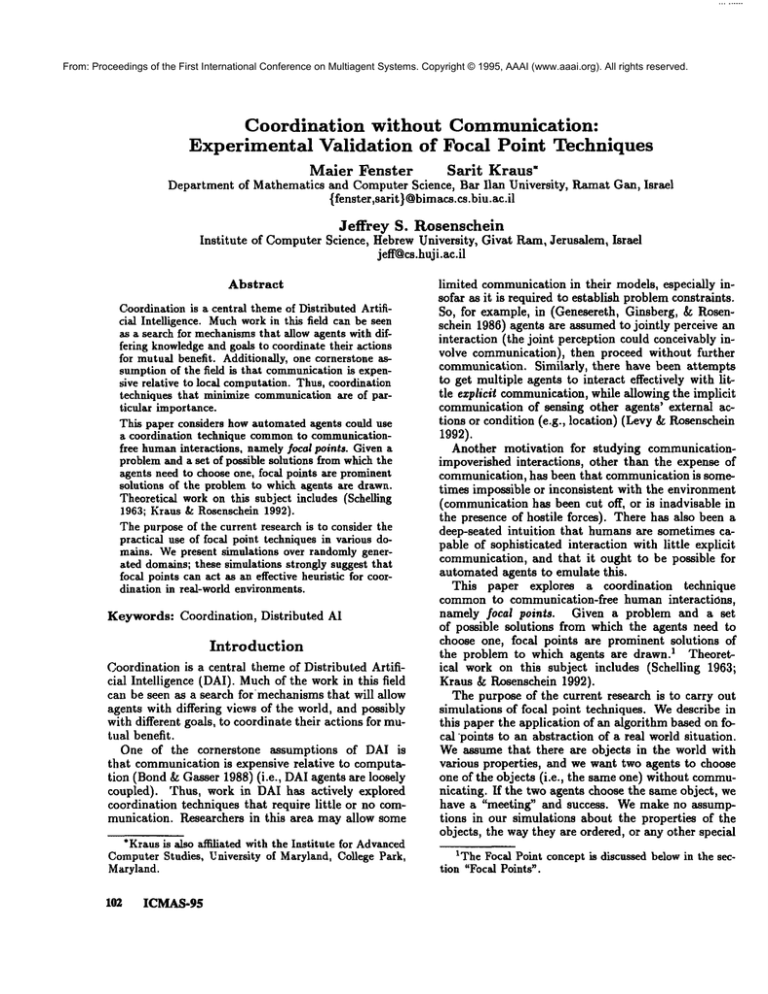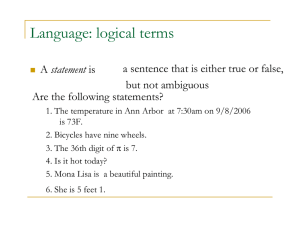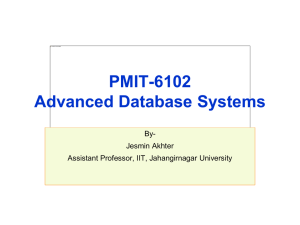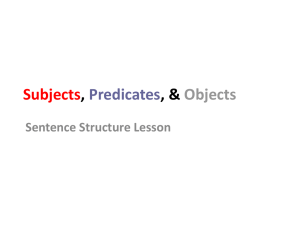
From: Proceedings of the First International Conference on Multiagent Systems. Copyright © 1995, AAAI (www.aaai.org). All rights reserved.
Coordination without Communication:
Experimental Validation of Focal Point Techniques
Maier Fenster
Sarit
Kraus*
Department of Mathematics and Computer Science, Bar Ilan University,
{fenster,sarit } @bimacs.cs.biu.ac.il
Institute
Jeffrey
S. Rosenschein
of Computer Science, Hebrew University, Gloat Kam,Jerusalem, Israel
jefl~cs.huji.ac.il
Abstract
Coordinationis a central themeof Distributed Artificial Intelligence. Muchworkin this field can be seen
as a search for mechanisms
that allow agents with differing knowledgeand goals to coordinate their actions
for mutualbenefit. Additionally, one cornerstone assumptionof the field is that communication
is expensive relative to local computation.Thus, coordination
techniques that minimize communicationare of particular importance.
This paper considers howautomated agents could use
a coordination technique commonto communicationfree humaninteractions, namelylocal points. Givena
problemand a set of possible solutions from whichthe
agents need to chooseone, focal points are prominent
solutions of the problem to which agents are drawn.
Theoretical workon this subject includes (Schelling
1963; Kraus & Rosenschein 1992).
The purpose of the current research is to consider the
practical use of focal point techniques in various domains. Wepresent simulations over randomly generated domains; these simulations strongly suggest that
focal points can act as an effective heuristic for coordination in real-world environments.
Keywords: Coordination,
Distributed
AI
Introduction
Coordination is a central theme of Distributed Artificial Intelligence (DAI). Muchof the work in this field
can be seen as a search for mechanismsthat will allow
agents with differing views of the world, and possibly
with different goals, to coordinate their actions for mutual benefit.
One of the cornerstone
assumptions of DAI is
that communication is expensive relative to computation (Bond &Gasser 1988) (i.e., DAIagents are loosely
coupled). Thus, work in DAI has actively explored
coordination techniques that require little or no communication. Researchers in this area may allow some
*Krausis also affiliated with the Institute for Advanced
ComputerStudies, University of Maryland, College Park,
Maryland.
102
ICMAS-9$
Itamat Gan, Israel
limited communicationin their models, especially insofar as it is required to establish problemconstraints.
So, for example, in (Genesereth, Ginsberg, & Rosenschein 1988) agents are assumed to jointly perceive an
interaction (the joint perception could conceivably involve communication), then proceed without further
communication. Similarly, there have been attempts
to get multiple agents to interact effectively with little ezplicit communication,while allowing the implicit
communication of sensing other agents’ external actions or condition (e.g., location) (Levy &Rosenschein
1992).
Another motivation for studying communicationimpoverished interactions, other than the expense of
communication, has been that communication is sometimes impossible or inconsistent with the environment
(communication has been cut off, or is inadvisable in
the presence of hostile forces). There has also been
deep-seated intuition that humans are sometimes capable of sophisticated interaction with little explicit
communication, and that it ought to be possible for
automated agents to emulate this.
This paper explores a coordination
technique
commonto communication-free human interactions,
namely focal points. Given a problem and a set
of possible solutions from which the agents need to
choose one, focal points are prominent solutions of
the problem to which agents are drawn. 1 Theoretical work on this subject includes (Schelling 1963;
Kraus & Rosenschein 1992).
The purpose of the current research is to carry out
simulations of focal point techniques. Wedescribe in
this paper the application of an algorithm based on focal ’points to an abstraction of a real world situation.
Weassume that there are objects in the world with
various properties, and we want two agents to choose
one of the objects (i.e., the same one) without communicating. If the two agents choose the same object, we
have a "meeting" and success. We make no assumptions in our simulations about the properties of the
objects, the way they are ordered, or any other special
XTheFocal Point concept is discussed belowin the section "Focal Points".
From: Proceedings of the First International Conference on Multiagent Systems. Copyright © 1995, AAAI (www.aaai.org). All rights reserved.
characteristics
of thedomain.
We presenta domain-independent
algorithmand
testit in simulations
of various
instances
of theabstractworld.Thepowerof focalpointsin coordinating commonchoicesamongagentswas highlyevident
in our simulations.
We foundthatin mostrandomly
generated
situations
thereis morethana 90%probabilitythattheagentswillmakea commonchoice,
and
in manycircumstances
theprobability
risesto 100%.
The Coordination
Problem
Twoagents are trying to choose the same object out of
a set of objects. The following examples might occur in
an environment where communication is difficult (radio frequency disturbance, or secrecy demandsduring a
battle, or the simple inability to communicatebecause
a specific frequency has been jammed), and therefore
an attempt must be made to come to an agreement
without any communication. There are various scenarios that might require this kind of communication-poor
interaction. For example, two agents that are out of
touch with one another must agree on the same plan of
action, out of a set of several equally reasonable plans.
Another example is of agents that are unable to communicate, but must choose one of several "safe houses"
where they will meet and communicate. Another possibility is whenagents mayneed to actually reestablish
communication, by choosing a radio frequency to use
for future messages.
The worldswe examinehavethefollowing
characteristics:
¯ Thereis a groupof objects
(denoted
by Term)outof
whichtheagentsmustchooseone (ideally
thesame
one).
¯ There is a set of predicates Pred. Each of the predicates P G Predhas two arguments:
an objectin
Termand a valuefromthe setPaluep,
so thateach
objecthasa valueforeachpredicate.
Forexample,
Color(l,
red)mightmeanthatobject1 is red,while
Height(i,
4) mightmeanthattheheightof object
is 4.
¯ Any characteristic
of an object can be encoded in
the values that the predicates can take. Weassume,
without loss of generality, that the predicates in Pred
2are ordered and numberedby 1, 2, 3, and so on.
Wemake the following additional assumptions:
1. The agents observe the same objects and properties in the world. They have the sets Term, ~Pred and
~aluep’s as described above.
2. The agents have great flexibility regarding their internal representations of the world, and these internal
2Thepredicates’ numbersare used only for the presentation of the paper. As is explainedbelow,weallow flexibility
regarding the agents’ internal representation. In particular,
we do not assume that the agents assign the same names
to the predicates.
representations of the different agents need not match
one another. For example, they may have different
predicates and may represent the value of the predicates differently.
3. Utility is only attached to success at choosing the
sameobject,
notto theselection
ofanyspecific
object
(i.e.,
theagents
areindifferent
amongobjects).
In gametheorythe aboveproblemcan be described
usinga gamematrix.
Oneagentneedsto choosea row
and the otheragentneedsto choosea column.The
payoff
foreachagentiswritten
inthecellspecified
by
their
respective
choices.
K
1
a
1
b
0
J
0
0
1
0
1
For example, the game matrix shown here can be
used to describe situations where two agents need to
choose the same object; if both agents choose the same
object (e.g., "a") their payoffs are 1 to each of them.
Otherwise, they both get 0.
Since the matrix is symmetric, there is no guarantee,
using game theory techniques, that the agents will both
choose the same object a and their chance of choosing
the same object is only 50%.
Focal Points
Originally introduced by Schelling (Schelling 1963;
Rasmusen 1989), focal points refer to prominent solutions of an interaction, solutions to which agents are
drawn. His work on this subject explored a number of
simple games where, despite surface equivalence among
many solutions, humanplayers were predictably drawn
to a particular solution by using contextual information. The following "toy example" illustrates the concept clearly.
Consider a TV game show, where two people have
each been asked to divide 100 identical objects into two
arbitrarily-sized piles. Their only concern in deciding
how much goes into each pile is to match the other
person’s behavior. If the two agents match one another, they each win $40,000, otherwise they get nothing. Schelling found that most people, presented with
this scenario, choose an even division of 50 objects per
pile. The players reason that, since at one level of
analysis all choices are equivalent, they must focus on
any uniqueness that distinguishes a particular option
(such as symmetry), and rely on the other person’s doing likewise. A similar problem has each person asked
to choose any positive number, with their only concern to match the other person’s choice. Most people
Sin these situations there axe multiple equilibria, and
there is a problem in choosing amongthem. Detailed discussion can be found in (Kraus & Rosenschein1992).
Fenster
lid
From: Proceedings of the First International Conference on Multiagent Systems. Copyright © 1995, AAAI (www.aaai.org). All rights reserved.
seem to choose the number1, it being tile only positive
ntunber without a predecessor.
There are a munl)er of intuitive properties that seem
to qualify a giw,n agreement as a focal point.. Among
these properties are uniqueness, symmetry, and extremeness. Even when we consider these special properties, more must be done to identify focal points. In
the TV game show example above, I, here is another
fairly strong contender for a solution in the choice of
() objects ill one pile. and 100 objects in the second
pile (or vice w, rsa). Of course, it. is precisely the "vice
versa" aspect of this solution that makes it appear less
aplwaling in comparison to tile 50 50 split.
In adN)ting the idea of focal points from humanbehavior patterns to Automated ~gents. one major diffen, nee must be considered. Focal points are based
on the naturalness and intuitiveness of certain objects
(or solutions) in the world. Automated agents do not
have the cultural hackground (commonsense) needed
to judge naturMness and intuitiveness. However, their
designers Call endow them with an algorithm capable
of identi~’ing focal points to which they will adhere.
The Focal Point
Algorithm
We devise a mathematical formula that specifies the
prominence of an object in tile world. This formula
is hased on intuitive properties such as rarity and extremeness. The premise of the work is that in any
random world some objects will have a predicate-vahle
vector that is different from those of other objccl.s, and
so the object itself will be marked as special. Sewmd
agents examining the same world, using the same formula, will see the same "special" objects. Focal point
~lgorithms provide a technique to choose one of these
"special objects" uniquely.
The algorithm described below is useful in situations
where a single designer builds both agents, 4 and sends
them to all environment about which s/he does not
have advanceinformation. If t he designer suspects thai.
the agents may lose colnun,nication and need to get
back in touch, s/he might choose to provide them with
a mechanism as described below. Since s/he doesn’t
know the exact details of their environment, the coordination policy can’t make use of instructions like
"go to the highest building," since there maynot. he a
unique building that satisfies the criterion.
The important point here is that the designer wants
to use ms little prior information t~s possible to aid the
agents’ coordination, but someprior information (e.g.,
the existence of certain predicates) might still be required by a focal point algorithm. This is not an marea.sonable demand. For example, tlm fact thai the
agents haw, certain sensors to which they have access
mirrors the prior ,,xist.ence of predicates that can be
4 Thealgorithmis also useful, if the agents weredesigned
by diffctvnt desigacrs, and they agreed by prior communic;dion to use this algorithm.
104
ICMAS-95
used in a focal point algorithm.
Algorithm 1 Joint selection
focal points
of an objeet using
l. Calc.ulate the focal point val.ae for all objects i E
Term using the following equation:
where Rie is the rarity of i with respect to predicate
P. i.e., howrare is the. raise oft relative to the other
objects, and Ef is the extremeness of i with respect
to predicate P, i.e., how Hose(r~lat.ivc to the other"
object O is th( value of i to one of the extreme val~
ues that predicate P takes in this particular u.orld.
Formally. assume P(i, x): then.
100
n.i = i{i, iP(i, x) is true in this u’orld}l
Suppose we have P(i,x), the order on l)alnet,
noted by <_ and >. and let MAX(i,P) be. the largest
of the following numbers: (t) numberof objects that
have the value r or" less for predicate P: (2) number of objects that have a value greater lhan x for
predicate P. Then we have
E[,.<_.> = 100MAX(i,
lT"erml P)
(3)
2. Choose the obflct c with the largest value that is
unique in having that value. Formally, let UFP=
{ill E 7-erm,Vi’ E "Term, if i’ ¢ i then F(i)
1"(i~)}. If UFP¢ ~ then c = argmaxie uFpF(i).
There are sew~ra.l aspects of the algorithm that were
chosen arbitrarily. 6 To norrnalize the vahles calculated.
an arbitrary factor of 100 was chosen. The extremeness
property was given a lower weight (0.5 in Equation 1),
becausc it seemed to be intuitively weaker than the
rarity property. Most importantly, the definitkms of
the rarity and extremeness properties arc arbitrary.
Another problem we faced in creating lhis algorithm
was the relative weight of the different predicates.
Since we chose to Assumethe maximumpossible flexibility in the internal representation of the agents, we
couldn’t assume that agents would identify the predicates in a similar manner. The solution, ,as mirrored in
the fornmla, was Io give equal weight to all the predicates.
.--,/..e
is only calculated if there is an order on the values
of the predicate P.
e;lt is important to emphasize that there iv no unique
"focal point algorithm":
rather, !here are many algorithms
thai migh! make use of the basic focal point idea. as presented above (the identification
and use of "prominent" ob.iecl.s to heuristic’,dly aid coordination}.
From: Proceedings of the First International Conference on Multiagent Systems. Copyright © 1995, AAAI (www.aaai.org). All rights reserved.
Example
Suppose there are five objects in the world and three
predicates: Type, Size and Color. The values of the
predicates with respect to the objects are given in the
following table.
[ object [ type
[size
1
1 (=bridge) 1 =small)
2
1 (--bridge) 2 =big)
3
2 (=house)
1 =small)
4
2 (=house) 2 =big)
5
2 (=house)
3 =huge)
color
1 (=red)
2 (=blue)
1 (=red)
3 (=brown)
3 (=brown)
Some examples of how one would calculate the extremeness and rarity values:
E~~r’ = Not relevant
R~Ve_ -lo___q
2 : 50
ESiZe,<,>
inn.
3
1
- = .... g=60
R~ize...= 100 :-. 50
The general formula for calculating the foca~ point
value in this example is: F(i) = R[vPe+.5*E~YPe’<’>+
Ri¯ i~.-,-,i~,<,>
+.o ,’~i - R~ozo,
+
+.5,E~OtOr,<,>
. See Figure 1.
Thus, the agents choose the big blue bridge, i.e.,
Object 2, which has the largest unique focal point
7number.
Properties
of the Algorithm
The focal point algorithm described above has the following properties:
Success Rate:
The high success rate of the algorithm is demonstrated
in the section "Results" below.
Front End:
If the focal point algorithm succeeds (i.e., UFP~ 0),
the agents will definitely meet. That is, both agents,
when choosing the object according to the algorithm,
know that the other agent will choose the same object,
too. That is the simplest case. In the rare cases that
the focal point algorithm fails, both agents knowthat it
failed (also commonknowledge), and so this algorithm
can be used as a front end for any other coordination
algorithm.
Simplicity and Intuitiveness
The algorithm is simple to describe, which is important in case it needs to be transmitted in a noisy environment (e.g., just before communication cut-off).
addition, the algorithm resembles human thought processes, which can help in communicating between man
and machine.
Complexity of the Algorithm:
One of the advantages of the focal point algorithm is
its low complexity:
Lemma 1 Given a set of objects Term and a set
of predicates 7~red, the complexity of Algorithm I is
O(lT-erml
* Maz(IPredl,
Log(lT"erm[)
)
rNote that in this case all the objects belongto the the
set UFPthat is defined in Algorithm1, however,Object 2
is the one that has the largest value.
Domain Independence:
Thealgorithm
is applicable
in anydomainwherethere
areobjects,
predicates,
andtheneedto chooseoneof
theobjects.
Independenceof Agents’ InternalRepresentations:
All agentsmusthavesetsof objects,predicates,
and valuesfor the predicates.
However,
the agents
may havedifferentnamesfor objects,predicates
and values.For example,one agent might see a
bighouseanda littlehouse,i.e.,Size(1,big)and
Size(2, little)
while, the other agent sees a medium
sized house Size(l, medium)and a small house respectively Size(2, small). Furthermore, agents may have
different namesfor the houses, i.e., the first agent may
denote the big house by 1 and the small house by 2,
and the second agent may call them 2 and 1 respectively. They mayalso use different terminology internally; the first agent may use the concept of "house"
and the second the concept of "building."
Description
of the Simulations
A configuration of the world included the number of
objects, and the number of predicates, in the world.
In each run of the simulation, a new random world
was created, by giving new values to the predicates.
First, the numberof values that a predicate could take
was randomly chosen from the range 2-20. Second, the
values were generated for each predicate/object pair.
The third step was to calculate the focal point value
for each object, as described by Algorithm 1. Finally,
if there was an object with a unique focal point value,
the run was considered a success; otherwise, it was a
failure.
To make the simulations computationally tractable,
we assumed that the world contained up to 19 objects,
that there were up to 9 orthogonal predicates, and that
each predicate had up to 20 different possible values.
For each configuration, 500 runs over random worlds
were simulated, giving a calculated accuracy of 5%
(with 95%probability (Devore 1991) [Section 7]).
final output of 500 runs for each configuration was a
number between 0 and 100 that represented the probability of finding an object with a unique focal point
value in a random world with the parameters described
above. That is, the numberrepresented the probability
that the agents will be in a world such that they deftnitely smeet when they use the focal point mechanism,
We conducted many sets of simulations.
In each
set of simulations, we varied some aspect of the world
(such as the distribution of the values of predicates and
the homogeneityof the world) so as to cover a variety
of situations in which agents might find themselves.
In this paper we present in detail only two sets of
simulations. These simulations, while quite abstract,
SThis in no way dependson the numberof agents in the
world.
Feaster
105
From: Proceedings of the First International Conference on Multiagent Systems. Copyright © 1995, AAAI (www.aaai.org). All rights reserved.
Object
1
2
3
4
5
~ype
5O
5O
33
33
33
ype
E~
0
0
0
0
0
i~e
R;
5O
5O
5O
5O
100
Eia.i,e,<_,> _~¢olor E~OlOr,<_,>r(i)
180
6O
50
0
8O
100
0
240
60
5O
0
163
80
5O
0
173
233
100
50
0
Figure h
cover wide variations of possible (real) worlds. The
first set of simulations was chosen to show that the
algorithm works in cases that are similar to our expectations regarding the nature of predicates in the real
world. The second set of simulations was chosen to
show that the algorithm works even if the representations that the agents (respectively) use for the world
are so different that the only commoninformation they
can use is whether two values are equal or not.
A. Different number of values, binomial and dependency distribution,
ordered values:
In this set of simulations, the world had the following
details (in addition to the general structure described
above):
1. The possible values in the world were distributed
using a binomial distribution.
2. Someof the predicates were statistically
dependent
on other predicates. For example, most trees are green,
and only very few are blue.
3. The predicates’ values were ordered.
The dependency among predicates was defined as follows: we chose randomly9 ~ of the predicates to be
dependent on the predicates before them, in the following manner. Assume Py(z, vj) and P/+l(z, vj+l);
then vj - L a "
between Oand/V-i:-~/1. + r where r was randomly chosen
B. Different
number of values, even distribution, non-ordered:
In this set of simulations, the world had the following
details (in addition to the general structure described
above):
1. The possible values in the world were evenly distributed.
2. No predicate was statistically
dependent on other
predicates.
3. The predicates did not have an internal order: given
two different values for a predicate, the agents could
not assign an order to them, they could only distinguish between them. For example, consider the predicate type. The values "table" and "chair" could not he
ordered, but the agents could tell them apart. Therefore, when using the algorithm described above, the
agents could not use the extremeness term, only the
rarity term.
In all other respects, this set of simulations was similar
°In
106
each run, different predicates werechosen.
ICMAS-9$
to the previous one.
Results
The results of cases A and B are presented in Figures 2 and 3 respectively. In these figures, the rows
correspond to the numberof objects in the tested configuration and the columns correspond to the number
of predicates in the tested configuration.
In general, the results of the simulations showthat
the success rate of the algorithm was very high. For
example, in case A (Figure 2) if there are at least
predicates and at least 3 objects in the configuration,
then in more than 97%of the worlds, the algorithm will
succeed. The only cases where there is a low success
rate is whenthere is only one predicate or two objects
°in the configurationJ
In case B (Figure 3), where there is no order
the values of predicates in the configuration, if there
are at least 4 predicates and at least 7 objects in the
configuration, then in more than 94% of the worlds
the algorithm will succeed. It is clear that whenthere
are only two objects there is no way to choose one
of them based only on rarity; therefore, we have the
zeros in row 1 in Figure 3.11 Also, when there is only
one predicate the probability that the algorithm will
t2
succeed is very low.
In general, the success rate of the algorithm rises
as the number of predicates or objects increases in
the world. However, when the number of predicates
in the world is very small the success rate of the algorithm doesn’t necessarily rise as the number of objects increases. It maybe that with a small numberof
predicates this specific algorithm tends to repeat the
same FP values for different objects, and therefore the
chance of finding an object with a unique focal point
value is relatively low.
l°As we explained above, in these cases the agents may
use a different "algorithm to increase their probability of
choosing the same object (see the section "Extension of
the Algorithmto Probabilistic Choice"belowfor details).
11Recall that in case B the values of the predicates are
not ordered, so that the extremenessterm in the focal point
formula in Algorithm 1 cannot be calculated.
12Thechance of finding a unique object in a world that
has only one predicate is obviouslylow.
From: Proceedings of the First International Conference on Multiagent Systems. Copyright © 1995, AAAI (www.aaai.org). All rights reserved.
No. of
Objects]
2
3
4
5
6
7
8
9
10
11
12
13
14
15
16
17
18
19
1 ]
81 72
95 99
90
97
93 99
91 99
89 100
87 99
99
87
89 99
"87 100
84 100
85 100
82 I00
83 99
8O 99
84 100
2]
82
99
98
100
99
I00
100
100
100
100
100
100
100
100
100
100
78I 99 100
78 99 100
No. of Predicates
3] 4] 5] 6] 7 I
79"
86
9O
99 99 99 100
98 99 100 99
100 100 100 100
100 100 100 100
100 100 100 I00
100 i00 I00 100
100 100 100 100
100 100 I00 100
100 100 I00 100
100 100 100 100
100 100 100 i00
100 100 100 100
100 100 100 100
100 100 100 100
100 100 100 100
100 100 100 100
100 100 100 100
8]
89
99
99
100
100
100
i00
100
100
100
100
100
100
100
100
100
100
100
9]
92
99
100
100
100
I00
100
100
100
100
100
100
100
100
100
100
100
100
Figure 2: Probability of Definitely Choosingthe SameObject in Case A
Short Description
of Other Experiments
As mentionedabove, in addition to experiments A and
B, manyadditionalexperiments were conducted. Some
of these experimentsare concisely described here.
Noise: Worlds with partial knowledgewere modeled
by adding randomnoise to one of the agent’s information (before the addition of noise, the agents had the
same knowledge,but used different representations).
As can be expected, the algorithm does not perform
as well in these cases as in cases A and B; however,it
still performsmuchbetter that randomchoice.
Expanded range of values: In other experiments
we explored the relationships between the numberof
values a predicate can have and the success rate of
the algorithm. Wediscovered that in general the success rate of the focal point algorithm increases with
the numberof values that a predicate can receive. In
addition, we discovered that even a small numberof
possible values wasgenerally enoughfor a high success
rate.
Exact knowledge: Another experiment was performedto test the added utility of using exact knowledge: both agents see the exact values of the predicates
in the world. Theprobability of success in these cases
was very similar to the success rate shownin this paper, although the chancesof success are significantly
higher whenthe numberof objects, predicates, or possible values in the world, is very small.
Extension of the Algorithm to Probabilistic
Choice: In previous sections, the focal point algorithm provided the agents with a mechanismfor guaranteeing their common
choice of the sameobject. However, evenwhenthe focal point algorithmfails, the in-
formation that it provides can be used to increase the
probability of choosing the same object. The agents
can look for the smallest set of objects such that their
focal point value is the same(if there’s morethan one
such set, they can choosethe one with the largest focal point value) and then chooseone of themrandomly.
Simulations we performed showedan increase in success rate over cases A and B.
Conclusions
Wehave presented the concept of focal point solutions to cooperation problems. Analgorithm was presented for discoveringuniquefocal points, and a series
of simulations were run over various randomlygenerated worlds that demonstrated the usefulness of the
focal point algorithmas a heuristic for multi-agentcoordination.
The algorithm is shownto be successful in a wide
variety of cases, including cases wherethe only informationthat the agents can use for their coordinationis
the non-orderedvalues of a few properties (predicates).
Acknowledgments
Thisresearch
hasbeenpartially
supported
by theIsraeli
Ministry
of Science
andTechnology
(Grant
0328284andGrant
4210),
by theIsrael
Science
Foundation
(Grant
032-7517),
andby theNational
Science
Foundation
underGrantNumber
IRI-9311988.
References
Bond, A. H., and Gasser, L. 1988. An analysis of
problems
andresearch
in DAI.In Bond,A. H.,and
Fenster
107
From: Proceedings of the First International Conference on Multiagent Systems. Copyright © 1995, AAAI (www.aaai.org). All rights reserved.
No.
No.
of
Objects
2
0
0
3
31 54
4
8 33
5
17 55
6
9 49
7
11 65
8
9 61
9
10 8O
10
10 75
11
11 81
12
12 8O
13
11 86
14
11 83
15
11 89
16
12 87
17
12 92
18
10 9O
19
10 92
3
0
68
42
76
68
88
82
92
92
97
97
99
97
99
99
100
99
100
0
77
55
86
81
94
96
99
98
99
99
99
99
99
100
100
100
100
of
re
P5dicates
0
0
8O 87
62 71
9O 93
88 93
97 98
97 99
99 99
99 99
99 100
100 100
100 100
100 100
100 100
100 100
100 100
100 100
100 100
7
0
88
75
94
95
98
99
99
100
100
100
100
100
100
100
100
100
100
0
91
82
97
96
99
99
100
100
100
100
100
100
100
100
100
100
i00
9
0
91
82
97
98
100
100
100
100
100
100
100
100
100
100
100
100
100
Figure 3: Probability of Definitely Choosingthe SameObject in Case of Different Numberof Values, EvenDistribution (B), Non-OrderedValues
Gasser, L., eds., Readingsin DistributedArtificial lntelhgence. San Mateo, California: MorganKaufmann.
chapter 1, 3-56.
Devore, J. L. 1991. Probability and Statistics for
Engineeringand Sciences. Pacific Grove, California:
Brooks/Cole Publishing Company.
Genesereth, M. R.; Ginsberg, M. L.; and Rosenschein,
J.S. 1986. Cooperation without communication. In
Proceedingsof The National Conferenceon Artificial
Intelligence, 51-57.
Kraus, S., and Rosenschein, J. S. 1992. The role of
representation in interaction: Discoveringfocal points
amongalternative solutions. In Decentralized AI,
Volume3. Amsterdam:Elsevier Science Publishers
B.V./North-Holland.
Levy, R., and Rosenschein, J. S. 1992. A gametheoretic approachto distributed artificial intelligence and
the pursuit problem.In DecentralizedArtificial Intelligence IIl. Amsterdam:Elsevier Science Publishers
B.V./North-Holland. 129 146.
Rasmusen, E. 1989. Gamesand I~lformation. Cambridge, Ma:Basil BlackwellLtd.
Schelling, T. C. 1963. The Strategy of Conflict. New
York: OxfordUniversity Press.
108 ICMAS-95







